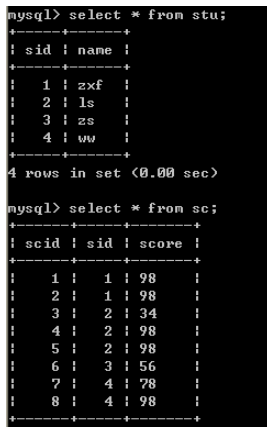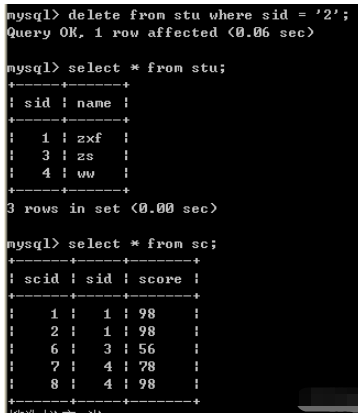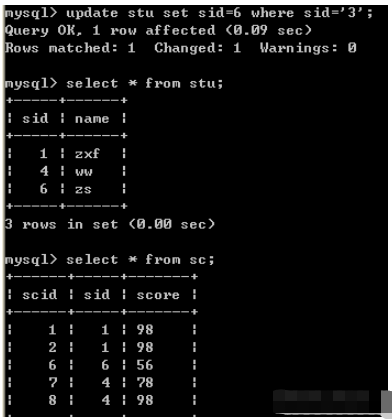How to implement MySQL foreign key cascade
Introduction
MySQL foreign keys play a constraint role and ensure data integrity at the database level.
For example, using the CASCADE (cascade concatenation) type of foreign keys, when a child table (such as user_info) is associated with a parent table (such as user), when the parent table is updated or deleted, the child table will update or delete records. This process is a database level completed.
There are many database designs in early enterprise systems. Although it helps programmers save delete and update operations, it actually increases hidden rules, increases software complexity, and weakens performance.
So in application design, we should try our best to ensure data integrity at the application layer (such as using transaction processing mechanism), rather than at the database level.
The following is an introduction to MySQL’s foreign keys.
The only storage engine that supports foreign keys in MySQL is InnoDB. When creating a foreign key, it is required that the parent table must have a corresponding index. Sub tableThe corresponding index will also be automatically created when creating foreign key.
When creating an index, you can specify the corresponding operations on the child table when deleting or updating the parent table, including
RESTRICT (restrict restriction)
NO ACTION
SET NULL
CASCADE (Concatenation)
RESTRICT is the same as NO ACTION, which means that when the child table has related records, the parent table cannot be updated;
CASCADE means parent tableWhen updates or deletes , updates or deletes the corresponding records of the child table ;
SET NULL means that when the parent table updates or deletes, the corresponding fields of the child table is SET NULL.
Example
Because only the InnoDB engine allows the use of foreign keys, our data table must use the InnoDB engine.
Create database:
Create database test;
1. First create two tables stu,sc
create table stu( sid int UNSIGNED primary key auto_increment, name varchar(20) not null) TYPE=InnoDB charset=utf8; create table sc( scid int UNSIGNED primary key auto_increment, sid int UNSIGNED not null, score varchar(20) default '0', index (sid), --外键必须加索引 FOREIGN KEY (sid) REFERENCES stu(sid) ON DELETE CASCADE ON UPDATE CASCADE) TYPE=InnoDB charset=utf8;
–Note: Foreign keys must be indexed;
FOREIGN key(sid) sets the foreign key, and sets sid as the foreign key
REFERENCES stu(sid) reference function. Reference the sid in the stu table
ON DELETE CASCADE cascade delete
ON UPDATE CASCADE cascade update
2. Insert data into two tables
insert into stu (name) value ('zxf'); insert into stu (name) value ('ls'); insert into stu (name) value ('zs'); insert into stu (name) value ('ww'); insert into sc(sid,score) values ('1','98'); insert into sc(sid,score) values ('1','98'); insert into sc(sid,score) values ('2','34'); insert into sc(sid,score) values ('2','98'); insert into sc(sid,score) values ('2','98'); insert into sc(sid,score) values ('3','56'); insert into sc(sid,score) values ('4','78'); insert into sc(sid,score) values ('4','98');

Note: When inserting data into the sc table, if the inserted sid is 22, the insertion will fail, violating the foreign key constraint, because the foreign key sid
comes from the primary key of id in the stu table. That is, the id in stu does not have data equal to 22.
Cascade deletion: Delete the student with id 2 in the stu table, and the student’s grades in the sc table will also be cascade deleted
delete from stu where sid = '2';

Cascade update: The student with id 3 in the stu table is changed to id 6, and the corresponding id of the student in the sc table will also be updated in cascade
update stu set sid=6 where sid='3';

Note
When deleting a table, you must first delete the foreign key table (sc), and then delete the primary key table (stu)

The above picture violates the foreign key constraint and cannot be Delete

#The picture above shows normal deletion. Delete the sc table first, and then delete the stu table!
The above is the detailed content of How to implement MySQL foreign key cascade. For more information, please follow other related articles on the PHP Chinese website!

Hot AI Tools

Undresser.AI Undress
AI-powered app for creating realistic nude photos

AI Clothes Remover
Online AI tool for removing clothes from photos.

Undress AI Tool
Undress images for free

Clothoff.io
AI clothes remover

Video Face Swap
Swap faces in any video effortlessly with our completely free AI face swap tool!

Hot Article

Hot Tools

Notepad++7.3.1
Easy-to-use and free code editor

SublimeText3 Chinese version
Chinese version, very easy to use

Zend Studio 13.0.1
Powerful PHP integrated development environment

Dreamweaver CS6
Visual web development tools

SublimeText3 Mac version
God-level code editing software (SublimeText3)

Hot Topics
 1658
1658
 14
14
 1415
1415
 52
52
 1309
1309
 25
25
 1257
1257
 29
29
 1231
1231
 24
24
 MySQL's Role: Databases in Web Applications
Apr 17, 2025 am 12:23 AM
MySQL's Role: Databases in Web Applications
Apr 17, 2025 am 12:23 AM
The main role of MySQL in web applications is to store and manage data. 1.MySQL efficiently processes user information, product catalogs, transaction records and other data. 2. Through SQL query, developers can extract information from the database to generate dynamic content. 3.MySQL works based on the client-server model to ensure acceptable query speed.
 How to start mysql by docker
Apr 15, 2025 pm 12:09 PM
How to start mysql by docker
Apr 15, 2025 pm 12:09 PM
The process of starting MySQL in Docker consists of the following steps: Pull the MySQL image to create and start the container, set the root user password, and map the port verification connection Create the database and the user grants all permissions to the database
 Laravel Introduction Example
Apr 18, 2025 pm 12:45 PM
Laravel Introduction Example
Apr 18, 2025 pm 12:45 PM
Laravel is a PHP framework for easy building of web applications. It provides a range of powerful features including: Installation: Install the Laravel CLI globally with Composer and create applications in the project directory. Routing: Define the relationship between the URL and the handler in routes/web.php. View: Create a view in resources/views to render the application's interface. Database Integration: Provides out-of-the-box integration with databases such as MySQL and uses migration to create and modify tables. Model and Controller: The model represents the database entity and the controller processes HTTP requests.
 Solve database connection problem: a practical case of using minii/db library
Apr 18, 2025 am 07:09 AM
Solve database connection problem: a practical case of using minii/db library
Apr 18, 2025 am 07:09 AM
I encountered a tricky problem when developing a small application: the need to quickly integrate a lightweight database operation library. After trying multiple libraries, I found that they either have too much functionality or are not very compatible. Eventually, I found minii/db, a simplified version based on Yii2 that solved my problem perfectly.
 MySQL and phpMyAdmin: Core Features and Functions
Apr 22, 2025 am 12:12 AM
MySQL and phpMyAdmin: Core Features and Functions
Apr 22, 2025 am 12:12 AM
MySQL and phpMyAdmin are powerful database management tools. 1) MySQL is used to create databases and tables, and to execute DML and SQL queries. 2) phpMyAdmin provides an intuitive interface for database management, table structure management, data operations and user permission management.
 Laravel framework installation method
Apr 18, 2025 pm 12:54 PM
Laravel framework installation method
Apr 18, 2025 pm 12:54 PM
Article summary: This article provides detailed step-by-step instructions to guide readers on how to easily install the Laravel framework. Laravel is a powerful PHP framework that speeds up the development process of web applications. This tutorial covers the installation process from system requirements to configuring databases and setting up routing. By following these steps, readers can quickly and efficiently lay a solid foundation for their Laravel project.
 MySQL vs. Other Programming Languages: A Comparison
Apr 19, 2025 am 12:22 AM
MySQL vs. Other Programming Languages: A Comparison
Apr 19, 2025 am 12:22 AM
Compared with other programming languages, MySQL is mainly used to store and manage data, while other languages such as Python, Java, and C are used for logical processing and application development. MySQL is known for its high performance, scalability and cross-platform support, suitable for data management needs, while other languages have advantages in their respective fields such as data analytics, enterprise applications, and system programming.
 MySQL vs. Other Databases: Comparing the Options
Apr 15, 2025 am 12:08 AM
MySQL vs. Other Databases: Comparing the Options
Apr 15, 2025 am 12:08 AM
MySQL is suitable for web applications and content management systems and is popular for its open source, high performance and ease of use. 1) Compared with PostgreSQL, MySQL performs better in simple queries and high concurrent read operations. 2) Compared with Oracle, MySQL is more popular among small and medium-sized enterprises because of its open source and low cost. 3) Compared with Microsoft SQL Server, MySQL is more suitable for cross-platform applications. 4) Unlike MongoDB, MySQL is more suitable for structured data and transaction processing.




